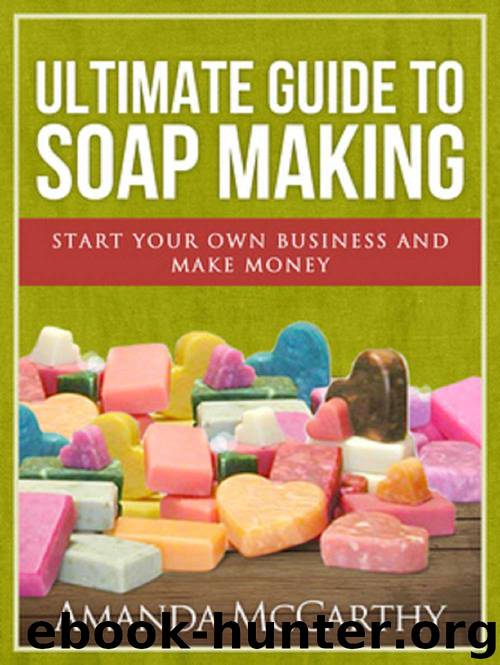Ultimate Guide To Soap Making by McCarthy Amanda

Author:McCarthy, Amanda [McCarthy, Amanda]
Language: eng
Format: epub, mobi
Published: 2013-12-26T16:00:00+00:00
When you're done adding all of the lye, add any remaining slushy or frozen liquid and stir until everything is melted and blended.
Moving on: Once the lye is fully dissolved, put the lid on and set the pitcher somewhere safe and secure from being knocked over, kicked over, or served into a drinking glass.
After half an hour, check the temperature - make sure you set the thermometer into the center of the liquid, not off to the side. Keep checking every ten minutes or so until it is the proper temperature (between 110 and 125, generally speaking; the recipe will specify).
Melt the fats and oils over low heat in a pot large enough to contain the lye solution and the rest of the recipe you're using with lots of room left over. Once they're melted, install a thermometer and set the pot off to the side to cool.
While the lye solution and the oil blend are cooling, prepare the mold(s): if it's a bread pan or similar, line with parchment paper. If it's something more intricate such as individual molds, line with plastic wrap. Molds for soapmaking may not need preparing at all - check on that well in advance.
Measure out your essential oils, fragrance oils, colorants, additives, etc, into individual pinch bowls. Once you have all the oils measured out safely, combine them in one bowl. By measuring each oil into an individual pinch bowl, you don't have to throw anything away if you accidentally oversplash - you just tip some back into the bottle and no harm done.
Blend up: once both the lye solution and the oil blend are at the temperature specified in the recipe (anywhere between 110F and 125F), slowly - slowly! - pour the lye solution into the oil mixture while using the stick blender. Keep the end of the blender down near the bottom of the pot to prevent any spraying.
Keep the blender going - making sure to get the sides in as well. After a while, the mixture will start to thicken and leave a small, quickly-vanishing trail as the blender moves around. This is the start of "Trace", which is when all the fun stuff happens. Keep going for a minute or two longer, then test the amount of trace by shutting off the blender and lifting it from the solution: if marks are left on the surface, you're there. It should have the consistency of thick mayonnaise.
Download
Ultimate Guide To Soap Making by McCarthy Amanda.mobi
This site does not store any files on its server. We only index and link to content provided by other sites. Please contact the content providers to delete copyright contents if any and email us, we'll remove relevant links or contents immediately.
On Writing A Memoir of the Craft by Stephen King(4892)
The Doodle Revolution by Sunni Brown(4713)
A Simplified Life by Emily Ley(4130)
Mummy Knew by Lisa James(3655)
Marijuana Grower's Handbook by Ed Rosenthal(3643)
Better Homes and Gardens New Cookbook by Better Homes & Gardens(3547)
Figure Drawing for Artists by Steve Huston(3409)
Paper Parties by Erin Hung(3398)
Draw Your Day by Samantha Dion Baker(3319)
The Genius of Japanese Carpentry by Azby Brown(3254)
The Code Book by Simon Singh(3139)
Japanese Design by Patricia J. Graham(3138)
Dangerous Girls by Haas Abigail(2997)
Lions and Lace by Meagan Mckinney(2941)
The Curated Closet by Anuschka Rees(2940)
How to Make Your Own Soap by Sally Hornsey(2867)
The Checklist Manifesto by Atul Gawande(2810)
The Wardrobe Wakeup by Lois Joy Johnson(2754)
Zero to Make by David Lang(2754)
